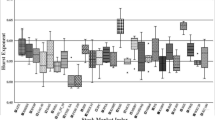Abstract
In this paper we investigate scaling properties of risky asset returns and make a strong case (1) against the need for multifractal models and (2) in favor of the requirement of heavy tailed distributions. Amongst the standard empirical properties of risky asset returns are an autocorrelation function for the returns which dies away rapidly and is statistically insignificant beyond a few lags, and also autocorrelation functions of squares and absolute values of returns which die away very slowly, persisting over years, or even decades. Together these indicate that, assuming returns come from a stationary process, they are not independent, but at most short-range dependent, while various functions of the returns are long-range dependent. These scaling properties are well known, although commonly ignored for modeling convenience. However, much more can be inferred from the scaling properties of the returns. It turns out that the empirical scaling functions are initially linear and ultimately concave, which is strongly suggestive of returns distributions with infinite low order moments or alternatively that multifractal behavior is a modeling requirement. Modifications of the commonly used models cannot readily meet these requirements. The evidence will be presented and its significance discussed, along with a class of models which can incorporate the empirically observed features.
Similar content being viewed by others
References
Fisher A, Calvet L, Mandelbrot B (1997) Multifractality of the Deutchmark/US Dollar exchange rates. Cowles Foundation Discussion Paper No. 1165
Gencay R, Dacarogna M, Muller U, Pictet O (2001) An introduction to high-frequency finance. Academic Press, San Diego
Heyde CC (1999) A risky asset model with strong dependence through fractal activity time. J Appl Prob 36: 1234–1239
Heyde CC (2002) On modes of long-range dependence. J Appl Prob 39: 882–888
Heyde CC, Kou SG (2004) On the controversy over tailweight of distributions. Oper Res Lett 32: 399–408
Heyde CC, Leonenko N (2005) Student processes. Adv Appl Prob 37: 342–365
Heyde CC, Liu S (2001) Empirical realities for a minimal description risky asset model The need for fractal features. J Korean Math Soc 38: 1047–1059
Heyde CC, Sly A (2007) Scaling properties of risky asset returns and their modelling implications. Manuscript in preparation
Mandelbrot B (2001) Scaling in financial prices: I Tails and dependence, II Multifractals and the star equation, III Cartoons of Brownian motion in multifractal time, IV Multifractal concentration. Quantitative Finance, 1:113–123 (I), 124–130 (II), 427–440 (III), 641–649 (IV)
Mandelbrot B, Fisher A, Calvet L (1997) A multifractal model of asset returns. Cowles Foundation Discussion Paper No. 1164
Rachev S, Mittnik S (2000) Stable Paretian models in finance. Wiley, New York
Sly A (2005) Self-similarity, multifractionality and multifractality. MPhil Thesis, Australian National University
Author information
Authors and Affiliations
Corresponding author
Rights and permissions
About this article
Cite this article
Heyde, C.C. Scaling issues for risky asset modelling. Math Meth Oper Res 69, 593–603 (2009). https://doi.org/10.1007/s00186-008-0253-6
Received:
Accepted:
Published:
Issue Date:
DOI: https://doi.org/10.1007/s00186-008-0253-6




